Research Article
In Silico Analysis to Elucidate the Antiviral Activity of Metabolites Present in MV Kashayam in Preventing the Entry and Multiplication of Covid-19
28351
Views & Citations27351
Likes & Shares
Objective: MV kashayam is a Siddha property drug having antiviral activity against COVID 19 belongs to the Siddha system of medicine, an ancient system of medicine used mainly in the Southern part of India using a variety of medicinal herbs to cure diseases of viral and unknown origin.
Method: The MV Kashayam was prepared as per the traditional Siddha formula. The crystal structure of Spike Protein of SARS-CoV-2 was obtained from Protein Data Bank and the structure was used to study the docking property using AutoDockTools using AutoDock Vina running on Windows 10 operating system.
Results: In the prepared MV Kashayam more than 85 alkaloids are present, it can able to provide antiviral activity against COVID 19 virus by exhibiting binding to the spike protein to the ACE-2 receptor. Among these Twenty four alkaloids of the compounds have very low energy for binding (less than -7 kcal/mol) indicating that they could have the potential to bind to the ACE-2 receptor.
Conclusion: The Siddha medicine, MV kashayam may be used as herbal medicine having antiviral activity against COVID 19 and can be recommended for COVID-19 patients after the clinical trial.
Keywords: MV Kashayam, Antiviral activity, Auto docking tools, Bioactive compounds, Energy binding
INTRODUCTION
Coronaviruses are a group of pathogenic viruses belonging to the family Coronoviridae and the order Nidovirales. They are known to cause respiratory or intestinal infections in humans and various animals [1]. Though the virus was reported in the 1930s, severe infections in humans were not reported until recently. Studies have suggested that up to 30% of all common colds could be attributed to coronaviruses [2]. In 2003, a pandemic due to a coronavirus was reported which was later named severe acute respiratory syndrome coronavirus (SARS-CoV) and was reported to cause around 10% mortality in infected individuals resulting in about 8000 deaths [1].
SARS-CoV was reported to cause more severe disease than the other previously known human coronaviruses and results in atypical pneumonia, fever, and shortness of breath [7]. Although the 2003 epidemic was carefully controlled by sensible health practices, the identification of SARS-like coronaviruses in bat reservoirs keeps the possibility of re-emergence of SARS-CoV or SARS-like viruses alive [3]. The other coronaviruses that are reported to infect humans include 229E, OC43, HKU1 and NL63. Among the infections by coronaviruses, Severe acquired respiratory syndrome (SARS) and Middle Eastern respiratory syndrome (MERS) led to the pandemic outbreak.
The recent outbreak of COVID-19 due to a novel coronavirus later named severe acute respiratory syndrome Coronavirus 2 (SARS-CoV-2) in China is causing a lot of panic around the world leading to a pandemic [4]. The virus has affected about 450,000 people throughout the work including the Americas, Europe, Asia and the Middle East. This human coronavirus is related to SARS-CoV and other bat coronaviruses like BtCoV-HKU4 and BtCoV-HKU5. Genetic analysis of bat coronavirus in Europe and Ghana revealed less than a 2% difference in SARS-CoV-2.
SARS-CoV-2 is known to be transmitted by person-to-person contact through aerosols and they can persist on inanimate surfaces for 2 hrs to 9 days. The most common clinical features include cough, fever and shortness of breath that could be progressed to severe pneumonia and renal failure. Pericarditis development and disseminated intravascular coagulation were observed in fatal cases. The Reproductive number (Ro) for SARS-CoV-2 is found to be around 3.28 which is higher than that of SARS [5]. SARS indicates that SARS-CoV-2 could be more widespread and transmissible than SARS.
M V Kashayam is a traditional Siddha medicine used for treating a variety of illnesses. The extract contains a combination of many plant metabolites that are present in the components of the extract. In silico analyses indicate that some of the metabolites of the extract are potent binders to the Spike protein of SARS-CoV-2. Since these metabolites are at the receptor binding site of SARS-CoV-2, these compounds could inhibit the virus-ACE-2 interaction. Hence they could potentially be effective in the prevention of infection by COVID-19. The present study has been made to study the antiviral activity of the herbal preparation using the computer model.
METHODOLOGY
The work was conducted at the Department of Biotechnology, Kalasalingam Academy of Research and Education, Krishnankoil, Tamilnadu, India.
Composition of the extract
M V Kashayam (MVK) is prepared as per the formulation described by the traditional Siddha text and is being used as an immune booster and is believed to exert anti-viral and antimicrobial effects. The compounds present in MVK are listed in Table 1.
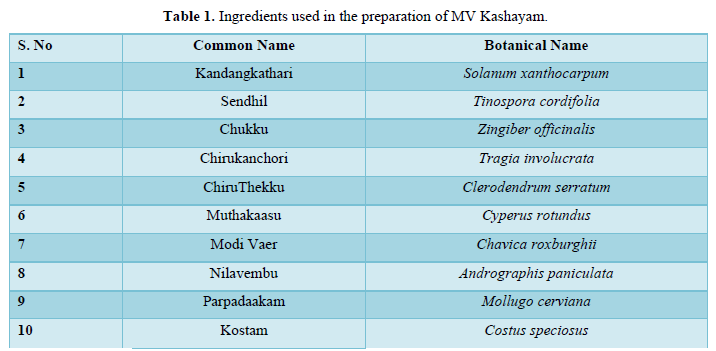
Collection of compounds
A literature search was done to find out the bioactive compounds present in the plant constituents of MV Kashayam. A total of ninety-eight plant metabolites were collected from either the literature or drug databases. The structures of the metabolites were retrieved. The lists of compounds present along with the structures are presented in Table 2. The compounds were prepared for docking by using the AutodockTools with the highest value of 10.
Crystal Structure of the Target
The crystal structure of Spike Protein of SARS-CoV-2 was obtained from Protein Data Bank and the structure was prepared for docking using AutoDockTools [4].
Molecular Docking Studies
Molecular docking studies were performed using AutoDock Vina running on Windows 10 operating system. The binding site information of SARS-CoV-2 Spike protein was obtained from the literature and the crystal structure. Molecules with low binding energies were considered binders and they could potentially interact with the Spike protein [6].
The crystal structure was obtained from Protein Data Bank and molecular docking studies were performed by using AutoDock. The binding site information of SARS-CoV-2 Spike protein was to be obtained from the literature and the crystal structure. Molecules with low binding energies were considered binders and they could potentially interact with the Spike protein and thereby prevent the entry of the virus.
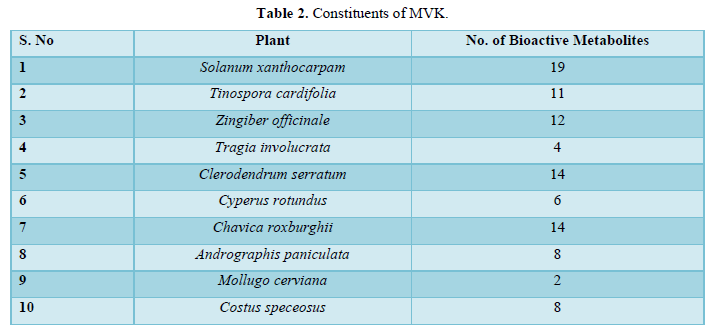
RESULTS AND DISCUSSION
Molecules with low binding energies were considered binders and they could potentially interact with the Spike protein and thereby prevent the entry of the virus. More than 85 numbers of the bioactive compounds present in this herbal plant combination are exhibiting binding properties to the ACE-2 receptor of the spike protein. Twenty-four of the 85 compounds required very low energy for binding (less than -7 kcal/mol) indicating that they could have the potential to bind to ACE-2 receptor. Interestingly 3 of the top 10 Compounds are from Solanum xanthocarpam and Costus speceosus. The compounds present in S. xanthocarpum include Diosgenine (-8.5 kcal/mol), Solasodine (-8.1 kcal/mol) and Tomatidenol (-8 kcal/mol). The other compounds include oleanolic acid (-8.6 kcal /mol) from Clerodendrum serratum. Beta-amyrin, Lupeol and Diosgenin from C. speceosus and Serratagenic Acid C. serratum, Friedelan-3-one from Tragia involucrate Vitexin from Mollugo cerviana (Figure 1). The binding potential of individual compounds is presented in Table 3. These results suggest that these metabolites could play an active role in the inhibition of viral entry by potentially inhibiting the viral-host interaction. The results are presented in Table 2.
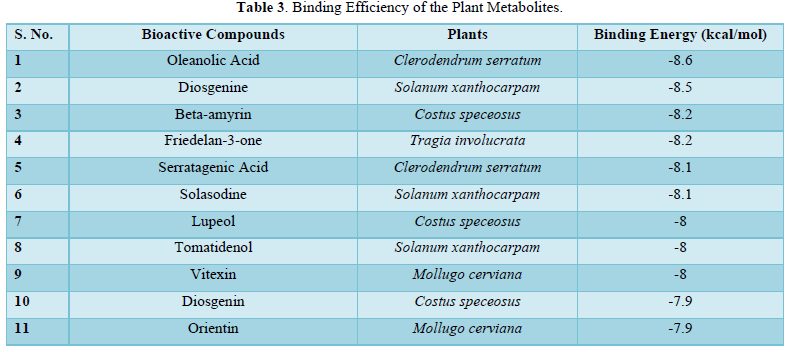
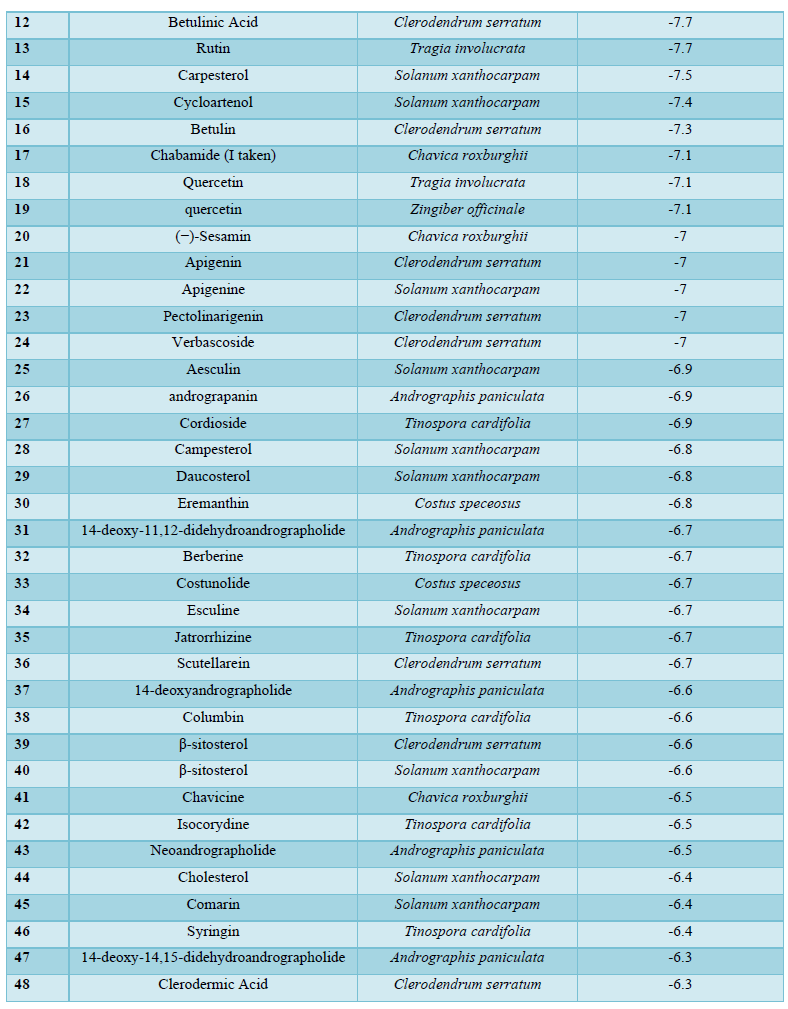
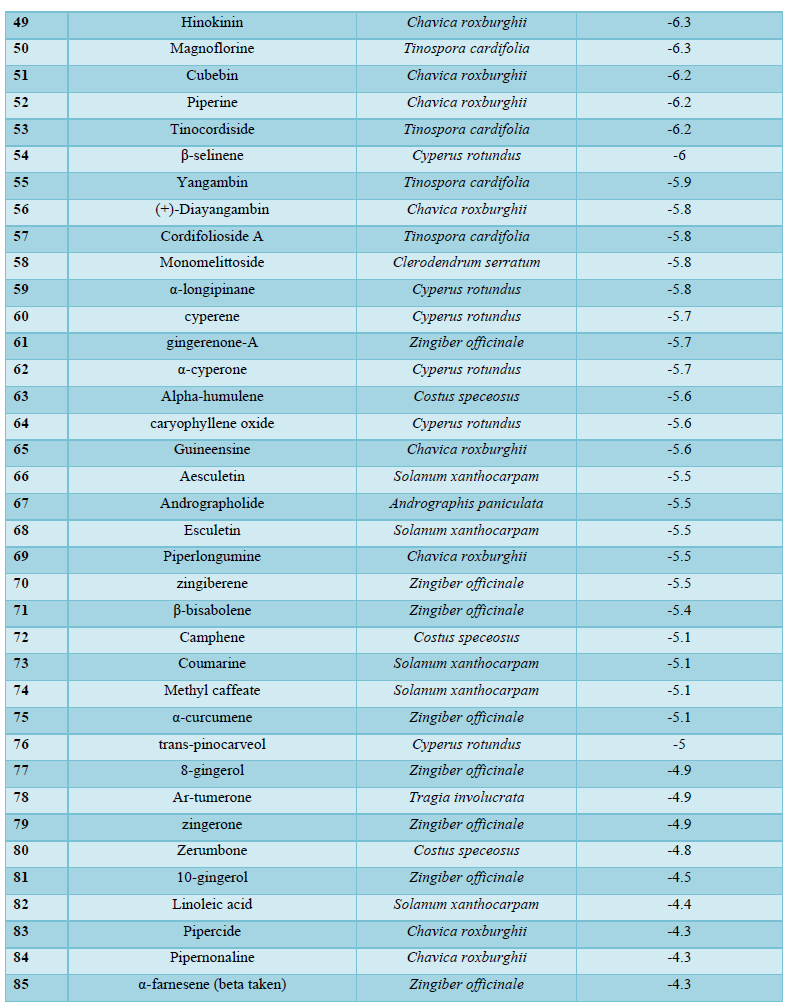
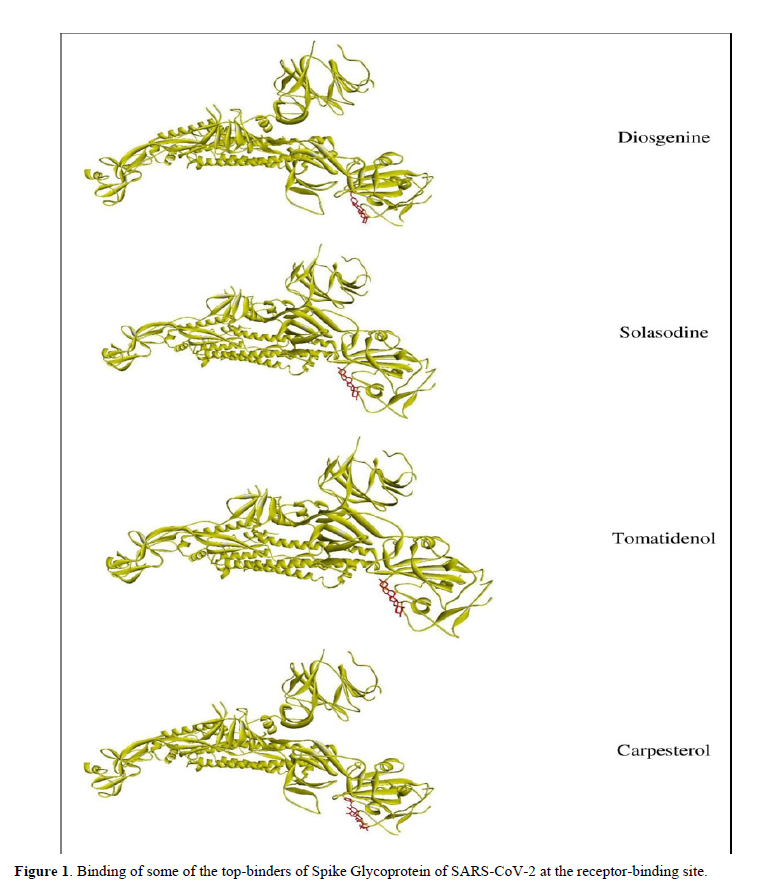
CONCLUSION
The present study revealed that the presence of various phytochemicals and bioactive compounds in the M V Kashayam, the preparation of a Siddha medicine has excellent antiviral ability against COVID 19 infection due to its promising activity against the viral spike glycoprotein to bind with host cell receptor, the activity was higher than Kabasura kudineer and Thonthasura Kudineer. Further preclinical and clinical pharmacology studies are required to develop M V Kashayam as a potential Siddha medicine against COVID 19.
DECLARATIONS
Acknowledgements: The author would like to thank Prof. Dr Sundar, Director, Department of Biotechnology, Kalasalingam Academy of Research and Education, Krishnankoil, Tamil Nadu for providing the facility, support and encouragement to carry out the research work. The investigators thank the Health Secretary, Director of Indian Medicine and Homeopathy, Government of Tamil Nadu, Director General of CCRS, Government of India for giving necessary directions and support to carry out the research work in a reputed institution.
Approvals: The preclinical trial for antiviral activity of MV kashayam was conducted with due approval from the ethical committee of KM College of Pharmacy, Madurai.
Consent: No consent is required for this study.
AUTHORS’ CONTRIBUTIONS
Based on the Siddha system of medicine (Indian system of medicine) the authors jointly developed a kashayam using a new herbal drug combination. Preparation of kashayam, literature review, was done by Dr Dharumarajan P and assisting of the docking system, data collections, analysis, and drafting and finalizing of the manuscript to be published was done by Dr Malarkannan SP and Hariyohesh MK.
CONFLICTS OF INTEREST
The authors have no conflicts of interest.
AUTHORS’ FINDINGS
The authors conducted an Autodocking study with the bioactive compounds and alkaloids present in developed MV Kashayam of herbal drug combination on spike proteins of COVID-19 virus with the due collection of data from protein banks competent authorities and concluded that the developed MV Kashayam with herbal combination may have concrete results to prevent the entry by adherence of virus with body cells and multiplication of COVID 19 virus thereby recommended for prevention, and treatment of COVID-19 patients with proper clinical trials.
FUNDING AGENCY
There are no funding sources.
-
Vincent MJ, Bergeron E, Benjannet S, Erickson BR, Rollin PE, et al. (2005) Chloroquine is a potent inhibitor of SARS coronavirus infection and spread. Virol J2: 69.
-
Mesel-Lemoine M, Millet J, Vidalain P-O, Law H, Vabret A, et al. (2012) A Human Coronavirus Responsible for the Common Cold Massively Kills Dendritic Cells but Not Monocyte. J Virol 86 (14): 7577-7587.
-
Tong S, Conrardy C, Ruone S, Kuzmin IV, Guo X, et al. (2009) Detection of novel SARS-like and other coronaviruses in bats from Kenya. Emerg Infect Dis 15(3): 482-485.
-
Cosconati S, Forli S, Perryman LP, Harris R, Goodsell D, et al (2010) Virtual Screening with AutoDock. Theory and Practice. Expert Opin Drug Discov 5(6): 597-607.
- Guan WJ, Ni ZY, Hu Y, Liang WH, Ou CQ, et al. (2020) Clinical Characteristics of Coronavirus Disease 2019 in China. N Engl J Med 382: 1708-1720.
- Surya RU, Praveen NA (2021) Molecular docking study of SARS-CoV-2 main protease against phytochemicals of Boerhavia diffusa Linn. For novel COVID-19 drug discovery. Virus Dis 32(1): 46-54.
- Ksiazek TG, Erdman D, Goldsmith CS, Zaki SR, Peret T, et al. (2003) A novel coronavirus associated with severe acute respiratory syndrome. N Engl J Med 348(20): 1953-1966.
- Bai Y, Yao L, Wei T, Tian F, Jin DY, et al. (2020) Presumed Asymptomatic Carrier Transmission of COVID-19. JAMA 323(14): 1406-1407.
-
Chen N, Zhou M, Dong X, Qu J, Gong F, et al. (2020) Epidemiological and clinical characteristics of 99 cases of 2019 novel coronavirus pneumonia in Wuhan, China: A descriptive study. Lancet 395: 507-513.
-
Park M, Cook AR, Lim JT, Sun Y, Dickens BL (2020) A Systematic Review of COVID-19 Epidemiology Based on Current Evidence. J Clin Med 9: 967.
-
Zhong NS, Zheng BJ, Li YM, Poon, Xie ZH, et al. (2003) Epidemiology and cause of severe acute respiratory syndrome (SARS) in Guangdong, People's Republic of China, in February 2003. Lancet 362(9393): 1353-1358.
-
Wu F, Zhao S, Yu B, Chen YM, Wang W, et al. (2020) A new coronavirus associated with human respiratory disease in China. Nature 579(7798): 265-269.



